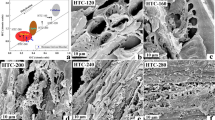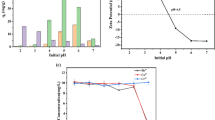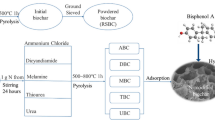Abstract
Environmental benefits of biochar require a simple and effective method for preparation of functional N-doped biochar. In this study, urea/ZnCl2 was developed to prepare N-doped biochar via in situ hydrothermal carbonization (HTC) of Camellia sinensis waste at 120–280 °C for 2 h under 1.0–9.8 MPa. Physicochemical and structural properties of the N-doped biochar were investigated by Raman spectra, elemental analysis, BET surface area, SEM, TEM, XRD, and XPS. The results showed that the N content in biochar could reach up to 7.79% at 280 °C. Surface chemistry suggested that pyridinic N, pyrollic N, and graphitic N were the major N species on the biochar. Moreover, the N-doped biochar was successfully employed to remove metal ions Cu2+, Pb2+, Zn2+, and Cr6+. Adsorption data fit closely to the pseudo-second-order kinetic equation and the Langmuir adsorption isotherm model for all metal ions.






Similar content being viewed by others
References
Acharya J, Sahu JN, Sahoo BK, Mohanty CR, Meikap BC (2009) Removal of chromium (VI) from wastewater by activated carbon developed from Tamarind wood activated with zinc chloride. Chem Eng J 150(1):25–39
Cai Z, Yang X, Lin G, Chen C, Chen Y, Huang B (2018) On preparing highly abrasion resistant binderless and in situ N-doped granular activated carbon. RSC Adv 8:20327–20333
Cheng B, Zeng RJ, Jiang H (2017) Recent developments of post-modification of biochar for electrochemical energy storage. Bioresour Technol 246:224–233
Chuah TG, Jumasiah A, Azni I, Katayon S, Choong SYT (2005) Rice husk as a potentially low-cost biosorbent for heavy metal and dye removal: an overview. Desalination 175(3):305–316
Daegi K, Yoshikawa K, Kiyoung P (2015) Characteristics of biochar obtained by hydrothermal carbonization of cellulose for renewable energy. Energies 8(12):14040–14048
Dai C, Wan J, Yang J, Qu S, Jin T, Ma F, Shao J (2018) H3PO4 solution hydrothermal carbonization combined with KOH activation to prepare argy wormwood-based porous carbon for high-performance supercapacitors. Appl Surf Sci 444:105–117
Funke A, Ziegler F (2010) Hydrothermal carbonization of biomass: a summary and discussion of chemical mechanisms for process engineering. Biofuels Bioprod Biorefin 4(2):160–177
Gao Y, Xu S, Yue Q, Ortaboy S, Gao B, Sun Y (2016a) Synthesis and characterization of heteroatom-enriched biochar from keratin-based and algous-based wastes. Adv Powder Technol 27(4):1280–1286
Gao YF, Wang HT, Guo JH, Peng P, Zhai MZ, She D (2016b) Hydrothermal degradation of hemicelluloses from triploid poplar in hot compressed water at 180-340 °C. Polym Degrad Stab 126:179–187
Gao YF, Zhou YB, Zhang Q, Zhang K, Peng P, Chen LC, Xiao B (2017) Hydrothermal extraction, structural characterization, and inhibition HeLa cells proliferation of functional polysaccharides from Chinese tea Zhongcha 108. J Funct Foods 39:1–8
Gascó G, Paz-Ferreiro J, Álvarez ML, Saa A, Méndez A (2018) Biochars and hydrochars prepared by pyrolysis and hydrothermal carbonisation of pig manure. Waste Manag 79:395–403
Hammes K, Smernik RJ, Skjemstad JO, Schmidt MWI (2008) Characterisation and evaluation of reference materials for black carbon analysis using elemental composition, colour, BET surface area and 13C NMR spectroscopy. Appl Geochem 23(8):2113–2122
Ho SH, Zhu S, Chang J (2017) Recent advances in nanoscale-metal assisted biochar derived from waste biomass used for heavy metals removal. Bioresour Technol 246:123–134
Hossain MA, Ganesan PB, Sandaran SC, Bin Rozali S, Krishnasamy S (2017) Catalytic microwave pyrolysis of oil palm fiber (OPF) for the biochar production. Environ Sci Pollut Res 24(24):26521–26533
Iberahim N, Sethupathi S, Bashir MJK (2018) Optimization of palm oil mill sludge biochar preparation for sulfur dioxide removal. Environ Sci Pollut Res 25(26):25702–25714
Kołodyńska D, Wnętrzak R, Leahy JJ, Hayes MHB, Kwapiński W, Hubicki Z (2012) Kinetic and adsorptive characterization of biochar in metal ions removal. Chem Eng J 197(29):295–305
Licursi D, Antonetti C, Bernardini J, Cinelli P, Coltelli MB, Lazzeri A, Martinelli M, Galletti AMR (2015) Characterization of the Arundo Donax L. solid residue from hydrothermal conversion: comparison with technical lignins and application perspectives. Ind Crop Prod 76:1008–1024
Liu W, Jiang H, Yu H (2015) Development of biochar-based functional materials: toward a sustainable platform carbon material. Chem Rev 115(22):12251–12285
Liu HM, Ma MH, Xie XA (2017) New materials from solid residues for investigation the mechanism of biomass hydrothermal liquefaction. Ind Crop Prod 108:63–71
Mangun CL, Benak KR, Economy J, Foster KL (2001) Surface chemistry, pore sizes and adsorption properties of activated carbon fibers and precursors treated with ammonia. Carbon 39(12):1809–1820
Peiris C, Gunatilake SR, Mlsna TE, Mohan D, Vithanage M (2017) Biochar based removal of antibiotic sulfonamides and tetracyclines in aquatic environments: a critical review. Bioresour Technol 246:150–159
Ramesh S, Sundararaju P, Banu KSP, Karthikeyan S, Doraiswamy U, Soundarapandian K (2019) Hydrothermal carbonization of arecanut husk biomass: fuel properties and sorption of metals. Environ Sci Pollut Res 26(4):3751–3761
Sevilla M, Maciá-Agulló JA, Fuertes AB (2011) Hydrothermal carbonization of biomass as a route for the sequestration of CO2: chemical and structural properties of the carbonized products. Biomass Bioenergy 35(7):3152–3159
Shang T, Ren R, Zhu Y, Jin X (2015) Oxygen- and nitrogen-co-doped activated carbon from waste particleboard for potential application in high-performance capacitance. Electrochim Acta 163:32–40
She D, Dong JE, Zhang JH, Liu LL, Sun QQ, Geng ZC, Peng P (2019) Development of black and biodegradable biochar/gutta percha composite films with high stretchability and barrier properties. Compos Sci Technol 175:1–5
Simsir H, Eltugral N, Karagoz S (2017) Hydrothermal carbonization for the preparation of hydrochars from glucose, cellulose, chitin, chitosan and wood chips via low-temperature and their characterization. Bioresour Technol 246:82–87
Song CF, Shan SD, Muller K, Wu SC, Niazi NK, Xu S, Shen Y, Rinklebe J, Liu D, Wang HL (2018) Characterization of pig manure-derived hydrochars for their potential application as fertilizer. Environ Sci Pollut Res 25(26):25772–25779
Wang JG, Chen N, Feng CP, Li M (2018) Performance and mechanism of fluoride adsorption from groundwater by lanthanum-modified pomelo peel biochar. Environ Sci Pollut Res 25(16):15326–15335
Wei L, Mcdonald AG, Stark NM (2015) Grafting of bacterial polyhydroxybutyrate (PHB) onto cellulose via in situ reactive extrusion with dicumyl peroxide. Biomacromolecules 16(3):1040–1049
Xia Y, Meng L, Jiang Y, Zhang Y, Dai X, Zhao M (2015) Facile preparation of MnO2 functionalized baker’s yeast composites and their adsorption mechanism for cadmium. Chem Eng J 259:927–935
Xiao LP, Shi ZJ, Xu F, Sun RC (2012) Hydrothermal carbonization of lignocellulosic biomass. Bioresour Technol 118:619–623
Xu G, Han J, Bing D, Ping N, Jin P, Hui D, Li H, Zhang X (2015) Biomass-derived porous carbon materials with sulfur and nitrogen dual-doping for energy storage. Green Chem 17(3):1668–1674
Yin QQ, Zhang BD, Wang RK, Zhao ZH (2017) Biochar as an adsorbent for inorganic nitrogen and phosphorus removal from water: a review. Environ Sci Pollut Res 24(34):26297–26309
Yousefifar A, Baroutian S, Farid MM, Gapes DJ, Young BR (2016) Hydrothermal processing of cellulose: a comparison between oxidative and non-oxidative processes. Bioresour Technol 226:229–237
Yu W, Lian F, Cui G, Liu Z (2018) N-doping effectively enhances the adsorption capacity of biochar for heavy metal ions from aqueous solution. Chemosphere 193:8–16
Zhang CS, Liu L, Zhao MH, Rong HW, Xu Y (2018) The environmental characteristics and applications of biochar. Environ Sci Pollut Res 25(22):21525–21534
Zhang SQ, Yang X, Ju MT, Liu L, Zheng K (2019) Mercury adsorption to aged biochar and its management in China. Environ Sci Pollut Res 26(5):4867–4877
Zhao K, Li Y, Zhou Y, Guo W, Jiang H, Xu Q (2018) Characterization of hydrothermal carbonization products (hydrochars and spent liquor) and their biomethane production performance. Bioresour Technol 267:9–16
Zhou Q, Jiang X, Li X, Jia CQ, Jiang W (2018) Preparation of high-yield N-doped biochar from nitrogen-containing phosphate and its effective adsorption for toluene. RSC Adv 8:30171–30179
Funding
This work was supported by the National Natural Science Foundation of China (31700612, 31700521), Natural Science Foundation of Shaanxi Province (2018JQ3014, 2019JQ-082), and Technical System for Tea Industry of Shaanxi Province.
Author information
Authors and Affiliations
Corresponding authors
Additional information
Responsible editor: Tito Roberto Cadaval Jr
Publisher’s note
Springer Nature remains neutral with regard to jurisdictional claims in published maps and institutional affiliations.
Electronic supplementary material
ESM 1
(DOCX 2682 kb)
Rights and permissions
About this article
Cite this article
Guo, S., Gao, Y., Wang, Y. et al. Urea/ZnCl2 in situ hydrothermal carbonization of Camellia sinensis waste to prepare N-doped biochar for heavy metal removal. Environ Sci Pollut Res 26, 30365–30373 (2019). https://doi.org/10.1007/s11356-019-06194-8
Received:
Accepted:
Published:
Issue Date:
DOI: https://doi.org/10.1007/s11356-019-06194-8




